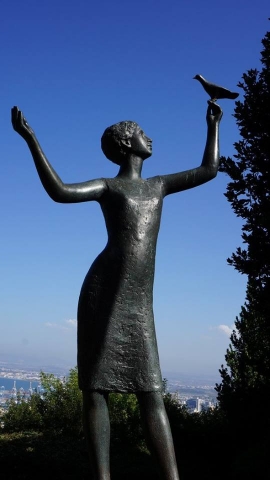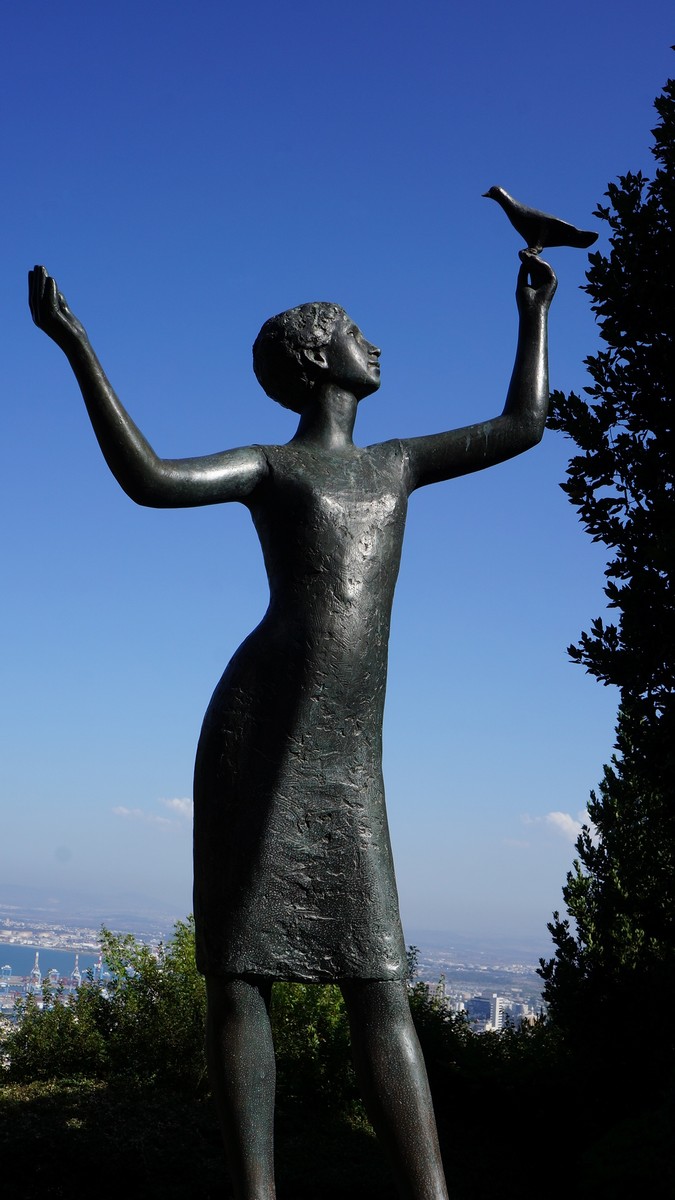
After visiting the Baha’i Gardens in Haifa, which closed at noon, I had no itinerary. I started walking down the hill.
“Lady, lady!” A stranger was calling me from a car.
“Yes?” I answered.
“Abraham said you needed a tour guide.” Abraham was the Kenyan security guard at Baha’i Gardens I’d been speaking with about his faith.
“Actually, I do. What do you suggest?”
Chaim gets out a map and points out the possibilities. We decide on an itinerary and a price. I enter the cab, grateful for Abraham’s initiative, and the bonus of seeing the historic town of Akko today. It’s much more efficient to travel with a local guide and dedicated transport.
Our first stop was aptly named the Peace Garden. A Jewish sculptor from Germany, Ursula Malbin, donated the sculptures years ago. I especially like the one of a woman holding a dove – a beautiful expression of peace.
As we drove to the next stop – the best falafel place in Haifa – Chaim tells me about his family’s experience in the army. Both he, and two of his children, completed their service. Chaim doesn’t think mandatory military service predisposes Israel to war; on the contrary, being in the army gives people discipline, a sense of community, and unites rich and poor. Orthodox Jews and Arab Israelis are exempt. I wonder how the dynamics would change if Arab and Jewish Israelis served alongside each other.
As I eat my messy falafel sandwich, I'm glad Chaim is doing the talking. “Soldiers understand that the gun is not the beginning and end of power,” he continues. "Instead, they seek peace, using violence as a last resort. Israel must have a strong army; it’s surrounded by Arab countries. In the Middle East, only the strong survive. Strength is what gives Israel peace; it earns it respect. Both the Arab and Jewish people want peace; it’s the politicians who make war."
"Hamas speaks from both sides of its mouth; it accepts funding for peace and social services from donors, and for war from supporters. They don’t spend any of their income on social programs or children; they use all of it for war."
We take a break from politics to enjoy some religious history. First we visit Stella Maris church, built over a cave where the prophet Elisha is believed to have lived. I'm surprised to find written prayers tucked into crevices in the cave. Next we visit the cave Elisha prayed in before confronting the priests of Baal (see 1 Kings 18:1-40 in the Bible). Donning a guest veil, I pass several women socialising on the women’s side; a Hasidic Jew is praying on the men's side. Inspired by Stella Maris, I tuck a prayer for peace in the wall.
On my return to the car, Chaim asks why I'm in Israel. I tell him my dream of supporting Israeli and Palestinian peacebuilders, and holding a dance at the wall.
“If 1,000 people like you come, there might be peace.”
May it be so! May God grant me divine appointments, help me discern my part in nurturing peace in this land.
“I believe peace comes from the heart, not the head,” I posit. “Both peace and war are emotional. If you’re afraid for your survival, you will defend yourself and ensure you can overpower your enemies. If you lose hope in justice, you might resort to violence. But if you trust each other, you can let down your guard, or challenge injustice peacefully.”
“If you trust other each other, you can let down your guard, or challenge injustice peacefully.”
It's also possible to interpret conflict in the positive sense of defending or prioritising your people. The trouble is, associating with your people too strongly can lead to excluding others. Jean Vanier writes eloquently about this in Becoming Human.
Bob Pierce, the founder of World Vision (one of the world's largest humanitarian organisations), prescribed the solution to tribalism decades ago – drawing bigger circles than anyone else, circles that include the other. The biggest circles include everyone in the global human family. That’s the size of circle I want to live in.
“The biggest circles include everyone in the global human family. That’s the size of circle I want to live in.”
- Log in to post comments

